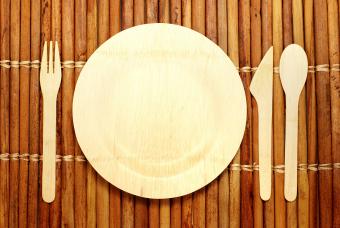
There are many benefits of using biodegradable plates. These plates and other forms of biodegradable food containers, offer an environmentally friendly alternative to traditional disposable items. While disposable food containers are convenient, they don't decompose. Food containers made from biodegradable materials combine the flexibility and convenience of disposable food containers with the environmental benefit of being fully biodegradable.
Benefits of Biodegradable Plates
The foremost benefit of using biodegradable plates is the positive impact it has on the environment. Choosing to use biodegradable plates for a picnic or cookout means less plastic being hauled off to the local landfill. Seaside celebrations avoid contributing to the ever growing plastic problem threatening aquatic life.
Renewable Base Material
Biodegradable plates are made from sustainable and renewable plants, such as sugar cane (bagasse), corn and potato starches, and various vegetable oils. Biodegradable plates are manufactured using eco-friendly sustainable practices, which means no toxins are used in the process or in the final product.

Biodegradable Plates and Products Reduce Ocean Pollution
According to National Geographic, each year the ocean is polluted with 18 billion pounds of every type of one-time-use plastics. Plastic is destroying not just irreplaceable eco-systems, such as coral reefs, but the aquatic life is suffering horrible deaths from consuming plastic bits floating in the ocean. Even baby fish are being harmed from ingesting microplastic.
Reduction in Landfill Mass
One of the biggest benefits of using biodegradable plates and other biodegradable products is the lessening of waste dumped into landfills. You can compost biodegradable plates in your backyard compost pile or send them to a composting site.
Eliminate Contact With Harmful Toxins
When you opt to use biodegradable plates and other products, you reduce the amount of toxins you come into contact with. You also avoid any possible plastic chemical or toxin leaching into food or drink when using plastic plates, cups, and other items. In addition, biodegradable plates don't pollute the environment with toxic chemical compounds.
Stronger Than Paper
From a usability standpoint, most biodegradable plates tend to be better choices for serving food since some paper plates often become soggy and collapse under the weight, heat and steam of foods. The majority of biodegradable plates are stronger than paper plates.
No Clean-Up
An added benefit to using biodegradable plates is not needed to wash them. The clean-up doesn't require using garbage bags, which create more plastic refuge. You simply add the plates to compost bin or compost pile.
Where to Purchase Biodegradable Plates
There are a wide range of biodegradable plates available. This includes small plates which are ideal for children's parties to large plates with lids that are well suited for larger meals or for entertaining. Biodegradable plates can be purchased online as well as from specialty stores. Online stores that offer a range of different plates and food containers include:
- Green Paper Products features several bagasse (sugar cane) plates that are biodegradable and compostable.
- Compostables sells a 9" plate with three compartments that's made from corn starch. The plate is 100% USDA Certified Biodegradable Content.
- Green Party Supply offers 10" plates made from sugar cane (bagasse) that are biodegradable and compostable.
Disposing of Biodegradable Plates and Other Food Containers
In order to fully realize the benefits of using biodegradable plates and other food containers, it is necessary to dispose of them properly. In order to decompose, items manufactured as biodegradable should never be sent to a landfill.
Biodegradable Plates Are Compostable
Biodegradable plates are compostable, meaning they can be placed in a compost bin or pile. The plates then decompose and are easily broken down in a short period of time (30-90 days). There are specific environmental and composting factors that determine the rate of decomposition, these include:
- Green waste is needed. This includes grass clippings, leaves and other types of vegetation as well as food.
- Microorganisms are needed in the compost bin/pile, such as aerobic bacteria and other bacteria and fungi.
- Macroorganisms are the workers, such as earthworms, and various insects that munch and further break down the organic matter.
- In addition to these required elements, the right amount of heat, moisture, nitrogen, and aeration are needed to complete the decomposing process.
Biodegradable vs Compostable Plates
Some manufacturers use compostable and biodegradable interchangeably, but this is incorrect. It can be very misleading to someone who wishes to purchase a biodegradable plate to toss onto their home compost heap, but end up with a compostable one instead.

Biodegradable Plates
A biodegradable plate is designed to turn into compost through the natural composting process of bacteria, heat, moisture, fungi, green material, and other factors that break it down. When placed in a composting bin or pile, it breaks down like any other composting material. You can use biodegradable plates in your home composting or send to a commercial composting site.
Compostable Plates
Compostable plates require certain conditions conducive to breaking the material down into compost. Your home compost bin or pile isn't sufficient enough to breakdown compostable plate materials.
BPI Compostable Plates
When manufacturers state their plates are compostable, it doesn't mean they are biodegradable plates. You should check on the packaging for the BPI (Biodegradable Products Institute) Certified label. This labeling ensures the plates can be composted at a commercial compost site. Compostable plates must meet the criteria of:
- Composting rate is equal to paper (cellulose) rate.
- Composted material, once broken down, cannot be distinguished within the compost.
- The break down process doesn't produce any type of toxic matter and the final result supports the growth of plants.
Commercial Compost Facilities
A commercial compost facility is specifically designed for compostable products. The facility provides a controlled environment conducive to breaking down the plates.
Compostable Plates and Landfills
If you toss compostable plates in regular trash that is buried in a landfill, the plates won't decompose the way they were designed. They will eventually breakdown in some landfills, unless the landfill is anaerobic (air locked). Without the oxygen necessary for decomposition, the plates won't decompose as they should.
Oils and Compostable Plates
Some plates made from oils can affect the composting process of the product. It's important to refer to the manufacturer's instructions regarding the best way to dispose of a compostable item.
Alternatives to Biodegradable Food Containers
All choices of disposable food containers have similar factors of resources, energy to manufacture, deliver and waste disposal. If you're seeking disposable plates, then biodegradable are the optimum choice. The environmental benefits with biodegradable plates and various food containers surpass other disposable choices for use and convenience of composting.
Compostable Plates and Food Containers
While compostable plates and other food containers are certainly a step up from Styrofoam ones, waste treatment requires you to find a commercial compost facility. Not all townships or cities have this type of waste center. Depending on your compost pile, attempting to compost this type of plate may prove challenging. Sending your compostable plates to the local landfill isn't a good choice since the plates could languish with other waste in an air-locked landfill.
- The Palm Leaf Plates by Verterra are made from fallen palm tree leaves, making them a 100% renewable resource. The plates are BPI-certified compostable.
- Stack Man offers 100% compostable 9" plates made from bagasse (sugar cane fibers).
- Bambu gives you an alternative choice for compostable plates. These Veneerware plates are made from certified organic bamboo. These one-time-use plates are disposable and compostable.
Other Alternatives: Reusable Plates and Food Containers
An alternative choice to disposable plates and food containers are reusable ones. These can be made of various materials, such as glass, china, or plastic. These alternatives to biodegradable and compostable containers can be washed and reused indefinitely.
Numerous Benefits of Using Biodegradable Plates
There are numerous benefits of using biodegradable plates when comparing to other disposable products. By far, biodegradable plates have a lesser environmental impact. For occasions where reusable plates and other containers are impractical, biodegradable or compostable plates can be a great alternative as long as you can compost them in your garden or send them to a commercial compost facility.







